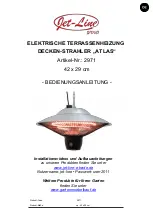
replac
ing the anode rod as needed.
Obtain new anode rods from a local
plumbing supplier or have a qualified
person replace it. (Anode rods are a
consumable item and are not covered
under warranty).
8
If sediment was present when
the tank was drained, flush the
tank by opening the cold water
supply valve and letting the water run
until no more sediment drains from the
tank. Close the drain valve when you
are done.
NOTICE:
Do not turn power back on
until the tank is completely full of water.
For complete instructions on filling the
tank, follow Step 8 in the Installation
section.
9
Refill the tank by opening the
cold water supply valve. Make
sure a hot water faucet is open
and the drain valve is closed. Allow the
hot water to run full for at least three
minutes to make sure the tank has all
the air removed and is completely full
of water. Failure to perform this step
can cause the upper heating element to
burn out. Once you are certain the tank
is completely full of water, close the hot
water faucet.
10
Restore power to the water
heater. It may take two hours
for the tank to heat up.
Replacing the Heating Element
WARNING! Working on an
energized circuit can result in severe
injury or death from electrical shock.
Turn power off. Check wires with a
non-contact circuit tester to make sure
power is off. When you are finished,
be sure all covers are secured to
reduce the risk of fire and electric
shock.
If you are not comfortable replacing a
heating element or thermostat yourself,
have this work done by a qualified
person. To replace the heating element,
you’ll need the following tools and
supplies:
Figure 28 -
Non-Contact Circuit Tester
• Always turn power OFF and check the
power wires with a non-contact circuit
tester before working on the water
heater.
Figure 29 -
Heating Element (with gasket)
• Check your water heater’s data plate
for the correct wattage and voltage.
Heating elements are available at
most hardware stores.
Figure 30 -
Element Wrench
• Some regular sockets (1 1/2 inch
SAE) may work, but regular sockets
are often beveled and may slip.
Inexpensive element wrenches are
available at
local plumbing supplier
.
• Garden hose to drain the tank
• Hand dishwashing soap to lubricate
the gasket
• A clean cloth to clean the threaded
opening
• A flat blade and a Phillips screwdriver
Steps for Replacing the Heating
Element:
1
Turn the power OFF at the circuit
breaker or remove fuses.
Figure 31 - Circuit Breaker
2
Open the electrical junction
box on the water heater. Using
a non-contact circuit tester,
check the power wires to make certain
the power is OFF.
Figure 32 -
Non-Contact Circuit Tester
3
Open a hot water faucet and
let the hot
water run until it is
cool.
Figure 33 -
Water Faucet
WARNING! Be sure the water runs
cool before draining the tank to reduce
the risk of scalding.
4
C
onnect a garden hose to the
drain valve and place the other
end of the hose in a drain or
outside (or use buckets). Turn OFF the
cold water valve that supplies the water
heater. Open the drain valve on the
water heater. Opening a hot water
faucet will help the tank drain faster.
Commercial Electric Water Heater Use and Care Guide • 25
MAINTENANCE








































